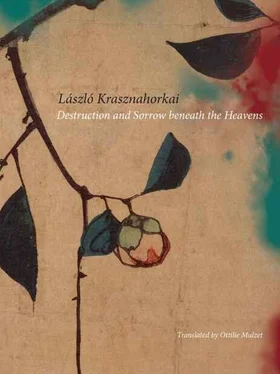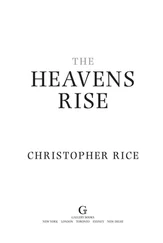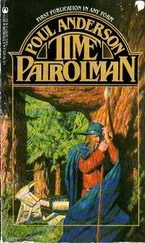fang. Yes, I understand what you’re saying. If, before building, there were plans made on paper. .
No, not exactly, Stein shakes his head. .
fang. . Many of the plans of the Suzhou gardens have been lost, but here, in Zhuozheng, fortunately they have remained. We know that the planner was someone named Wen Zhengming.[191] He was one of the four most significant artists of the end of the Ming era. There were four of them, and among them Wen was the representative of the highest level of culture of the Wu State.
It’s possible that the director misunderstood him but he, Stein, thinks that this line of thought may also prove fruitful. So they will speak of these four. Who were they? Literati? Painters? Poets? Gardeners?
fang. Among these four who were the most famous, there were painters and poets, and such, for example, was Wen Zhingming himself, who also painted and wrote poetry.
There was something Stein should have said, some formulaic courtesy; he has ruined something, or hasn’t done something, or isn’t doing something that he should, because he can sense that the conversation is beginning to run along a different track. So once again he applies himself, and returns the topic of conversation to the starting point, saying that, yes, as long as the plans are still extant, the garden can be newly created at any point, in that sense it is indestructible. . This is what he thought, and he was disappointed, he looks openly at the director, but now, here in Suzhou, to his greatest astonishment, he has come upon something that has been preserved, something undamaged, something that is not an imitation, not a falsification, but that has remained in the spirit of tradition, that has been resurrected or that has been carefully maintained. And because of that he would like to repeat, he continues, his glittering eyes fixed upon the director, what he has related just now of his initial train of thought: that everything can be destroyed, can be falsified, it can happen to a building, a temple, a ritual statue, a painting, even, if you will, a manuscript, and this is what is happening day after day, and all of these irreplaceable and irretrievable things are being falsified — but it now seems to him, here in these Suzhou gardens, bathed in their wondrous original state, that in the case of the Chinese garden there is hope. Because, he repeats, it can be repeated: all the vegetation, the chrysanthemum, the hydrangea, the wisteria, the lotus, the bamboo, and the plum trees, the paulownia, the pine and the apricot trees, all were essential elements in these gardens, and they still exist, they can be planted here; the stones which were necessary can also be quarried here, the principles, the plans, the vision of the essence of the whole contained in the plan, it all exists — so that, well there is still something from which we may obtain a definite picture of the traditions that have been lost. Do you agree?
The director is beaming.
fang. I agree, if we take into consideration the fact that the Chinese garden was an art that was constantly undergoing change, as anything else in the classical tradition. The concept of the garden, the style of the garden, the concrete goal of the construction of the garden always changed slightly according to the era, and everyone added something personal to the essence. So that when today we restore the garden, we still go back to the original, we still work with a view to the original plans, but we must consider these changes, as well as the personal contributions and features that occurred in the various eras. Moreover, we must not think that everything has remained unchanged as it was built here, or placed here. For example, there was a painting here on the wall, the creation of Wen Zhingming. We know from the original plans that it was here, and yet it is impossible to imagine that this picture could remain undamaged for 500 years, if it could even survive at all. So what, accordingly, should we do? We and our forebears have continually had to replace that which continually fell into ruin due to natural reasons: only that this substitution, this completion, had to be subordinated to extraordinarily strict rules. For example, if at one time a painting by Wen Zhingming was placed here, then we should place another painting by Wen Zhingming here, or something from the same era and which in the essence of its theme, its proportions, moreover in its atmosphere is essentially the same. We must always insist that here, in this place, another picture may not hang, only one such as I have described — we could never place a painting here created in a northern or Hong Kong style! This is the correct procedure, if we wish to remain within the same style.
But, Stein asks, how does he know? How does he know what the style is? The style within which he has to remain? Was this also preserved in the plans? In the descriptions?
fang. It is necessary for there to be an aesthetic sensibility in those who work with these traditions, these gardens. .
Fine, but where do these aesthetic sensibilities come from?
fang. This garden is 500 years old. If someone takes care of a garden like this for years, after a while, he will naturally possess these sensibilities. . Anyone who takes care of, who builds, who repairs a garden such as ours will be strongly affected by it. And I can indeed state with some pride that this process and mutual influence does bring results: the Zhouzheng Yuan is flourishing today. This garden has never been as beautiful as it is now. We have sacrificed a great deal, and we continue to sacrifice a great deal for this garden. And while we could never claim that it is perfect, as concerns my previous statements, I greatly trust that you shall not find them to be exaggerated. For this self-regarding praise does not at all mean that the Zhuozheng Yuan is perfect now. There is no perfect garden. Every garden has its faults. Just like a human being. One can only be en route to perfection.
May Stein enquire about his, the director’s, opinion as to the relationship between painting and the garden?
fang. In imperial times, painting and the garden were expected to fulfil the same functions. The highest order of magnitude in life was considered to be fulfilled when a painting or garden created within a person the feeling that he was returning to nature. The same delight was experienced in the melody of birdsong if it was seen in a painting or heard in a garden. Both were removed from reality. Both were art. Both were the location of the loftiness of the spirit.
It could have been the most amazing thing — Stein tries to lift the mood in the breathtakingly beautiful room — if in a garden, listening to birdsong, one could examine a painting in which just then a bird was singing amid the mountains. .
The director laughs. This is the first time he has laughed during their conversation.
fang. Well, yes. There are differing degrees of delight. .
The more serene atmosphere is not just a momentary matter; it is clear that now Stein has won the director’s confidence. Who is the soul of this garden? A person is necessary, who will truly keep it well in hand. Because, Stein says, he sees gardeners here, workers, people entrusted with certain tasks, but for this garden to remain in its splendid magnificence, someone who really understands it is necessary, someone who knows what must be done, for the miracle to remain a miracle. . Who is this person?
fang. Of course there is a chief director of the Zhuozheng Yuan, a chief manager, and that is myself. But you know, it hardly works in the way that you just imagined. The division of work is based upon a very strict order: there are groups of workers who watch over the plants, there are other groups who take care of the rocks, there is a particular group which deals with the bonsai trees, and there is yet another that builds the mountains. These workgroups are called ji gong, and within one ji gong we distinguish four levels. These four levels create a hierarchy which means that whoever is at the highest level is considered, due to his experience and knowledge, to be a fully competent, fully responsible expert in his field. And since most of our workers have been here for decades, everyone is extremely experienced, so it is not necessary to manage them in the sense in which you are thinking, because they already know what is correct, what has to be done in a given instance. I, however, their director, am not an expert in these questions. There is, for example, a special case here. We in this garden, located south of the Yangtze, must endure the so-called mildew rain during the rainy season. This mildew rain brings countless termites which ruin the wooden buildings, so the fight against them is of vital importance. We have certain groups trained only in this, and this is their only task — and I have no idea what they do. The important thing is that they protect the buildings from the termites. My role is just organizational, to keep the whole thing going smoothly.
Читать дальше












